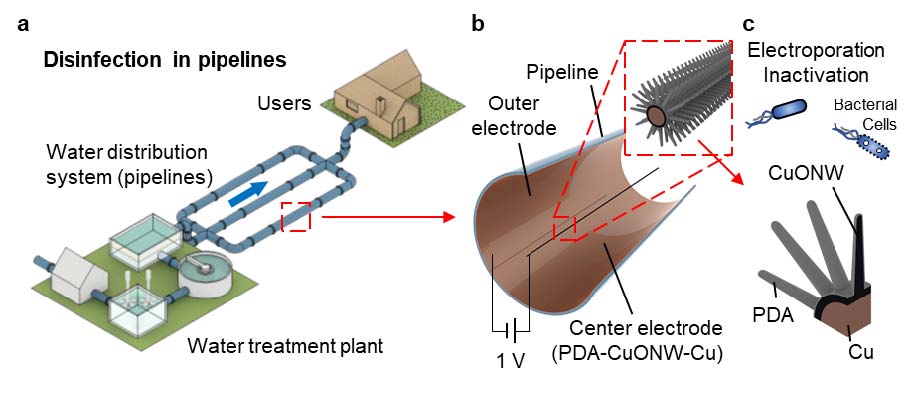Researchers at Georgia Tech have developed a device for chemical-free water disinfection in municipal pipelines. The coaxial-electrode electroporation disinfection cell (CEEDC) technology deactivates pathogens by exposing them to a high-strength electrical field and damaging the cell membrane. The technique is an alternative to conventional chlorine disinfection, which is associated with the generation of carcinogenic byproducts.
The CEEDC device consists of a cylindrical reactor chamber, two electrodes, a tubular outer electrode, and a coaxial center electrode with nanowires perpendicular to the surface. The nanowires enhance the local electric field by several orders of magnitude, enabling system operation with very low voltage (1-2 V) that is generated in situ by flowing water. The design enables a two-level electric field enhancement and directional cell transportation, both of which assist disinfection. This point-of-use disinfection technology minimizes the use of chemicals, requires little maintenance, and can be easily incorporated into existing water distribution systems.
- Efficient: Achieves rapid and universal pathogen inactivation with low power consumption
- Flexible: Features a configurable structure that can be placed easily into existing pipeline systems
- Chemical-free: Permits disinfection without the addition of chemicals that generate harmful and carcinogenic byproducts
This technology is for water disinfection in a wide range of pipeline systems:
- Municipal
- Swimming pools and water parks
- Hospitals
- Beverage companies
- Aquariums
Chlorine disinfection has been protecting people from lethal pathogenic diseases for more than 100 years. Though chlorination is a low-cost and easily applied solution, the formation of disinfection byproducts poses carcinogenic health threats. Other disinfection methods exist—ultraviolet radiation, membrane filtration, and ozonation—yet require high energy inputs and are unreliable. Low-voltage electroporation techniques have emerged as a promising water disinfection technique. Used in the medical field to deliver DNA and/or proteins into cells, electroporation works by increasing the permeability of the cell membrane. Georgia Tech researchers have adapted the technique to enable pathogen deactivation in water pipeline systems.

CEEDC disinfection in pipelines schematic. a. Concept of disinfection in pipelines in a municipal water treatment system b. Schematic of CEEDC configuration, including polydopamine (PDA) protection layer and copper oxide nanowires (CuONW) c. Schematic showing the nanowire-assisted electroporation inactivation of bacteria using low voltage
